From problem to product
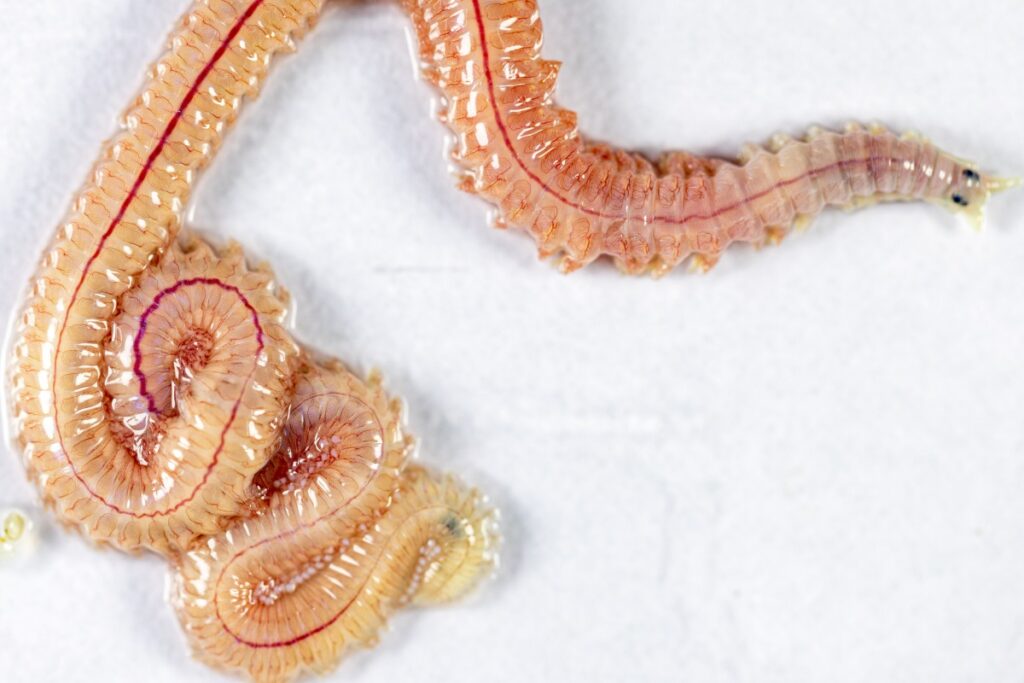
Sludge from fish farms and hatcheries is seen as waste, but it also contains potentially valuable resources
One of the advantages of fish farming with a recirculating aquaculture system (RAS) is that waste – in its various forms – can be collected rather than ending up in the ocean.
The bad news is that it is still necessary to do something with that waste. Increasingly, however, the industry is learning to see waste as a sidestream from its production process, rather than simply as a disposal problem.
In Denmark, a consortium led by water treatment specialists Alumichem has been awarded a grant as part of the Green Development and Demonstration Programme (GUDP) for the development of a system known as NAPRAS – “Effective Nitrogen (N) and Phosphorous (P) removal in [RAS] fish farming”.
The aim of the project is to develop and demonstrate a consolidated treatment system that reduces emissions of N in the forms of nitrate, nitrite and nitrous oxide (greenhouse gas) and P, as well as heavy metal contaminants in RAS. The treatment implements granulated sludge technology alongside P precipitation, wet electrochemical removal of heavy metals such as Zn, Cd and enrichment of P bioavailability, and finally drying to effectively remove >95% of N and capture >95% of P into a granular safe fertiliser product.
Alumichem is working in partnership with three other businesses: DTU Aqua, Clean Matter and Drying Matter.
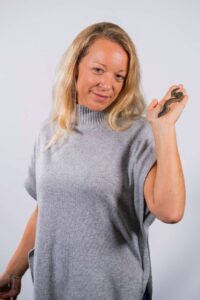
Dr Georgina Robinson with polychaete worm
The Department of Aquatic Resources (DTU Aqua) researches, advises, educates and contributes to innovation in sustainable use and management of aquatic resources. DTU Aqua is an institute at the Technical University of Denmark. Its scientists conduct research into the biology and population ecology of aquatic organisms, physical and chemical processes in the aquatic environment and ecosystem structure and dynamics, taking into account natural and anthropogenic influences.
Clean Matter is focused on closing the phosphorous cycle in the circular economy. They focus on phosphorous recovery from biomass waste streams, whether it is from municipal wastewater treatment or aquaculture. Their goal is to bring P back into the environment.
Drying Matter brings innovative and sustainable sludge drying solutions to their clients. The company converts wastewater sludge into easily manageable granules that can bring value back to the environment and the economy.
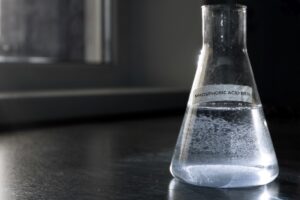
Phosphoric acid
The GUDP scheme supports innovative projects that promote green and economic sustainability in agriculture, fisheries, aquaculture and the food industry. GUDP is a programme run by the Danish Ministry of Food, Agriculture and Fisheries, with input from private sector representatives.
“DTU Aqua, Clean Matter and Drying Matter have been strong partners for us and we are always happy to execute on innovative and potentially disruptive projects with them,” says Christian Bang-Møller, Chief Technology Officer at Alumichem. “This is an exciting innovation project because we are seeing the environmental discharge limits within RAS become tighter and more complex.”
As Trevor Gent, Director of Engineered Solutions with Alumichem, explains, NAPRAS is “disruptive” in two ways: “The first is the footprint required to deploy traditional activated sludge treatment for denitrification is reduced by a significant factor (minimum of 50%), making it more affordable and easier to deploy in a market where footprint is at a premium… The removal rate of nitrous oxide is significantly increased, which ultimately reduces a major greenhouse gas.
“The second is in relationship to not only the removal of phosphorous but the availability of the phosphorous in the end. By focusing on removing greater than 99.5% of the P from the waste stream, we have to bind it as a precipitate, which can reduce its bioavailability but with the next step of ‘Power to P’, we can increase the bioavailability and ultimately the value of the product to the market.”
Waste management is an urgent issue for RAS farmers, who are facing strict rules on discharge limits in a number of jurisdictions. Not surprisingly, environmental regulators are looking to minimise the discharge of substances such as nitrogen and phosphorous into the water supply.
Gent says: “With NAPRAS, we are working to control both of those parameters while providing a small footprint and saleable product, which historically was just a waste stream.”
The NAPRAS team have three years to bring the pilot project to fruition. They are targeting deployment at both a fresh water and a saltwater site to work on the viability under both water conditions.
As well as simply removing nitrogen and phosphorous, the aim is to create sidestreams with value in their own right. Two examples are to produce usable phosphoric acid, which has a number of applications, and to produce dry sludge, which has a high organic content to be used as fertiliser or to enrich soil for agriculture.
Gent adds: “Currently the project will be deployed in Denmark, but the goal is to make the technology available to all countries and fish species.”
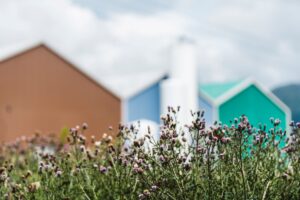
Scottish Sea Farms’ hatchery, Barcaldine
Bring on the worms
Chemistry is not the only science being applied to the problem of waste processing. Biology is playing its part as well – two separate projects are exploring a potential function for bristle worms.
Led by researchers at the Scottish Association for Marine Science (SAMS), with funding support from the Sustainable Aquaculture Innovation Centre (SAIC), the initiative could open up a new avenue for seafood producers to deal with waste in a more circular way. Scottish Sea Farms, technology supplier Power and Water, and waste services company Tradebe also support the research.
While most waste from aquaculture is already recycled, the results of this study could see byproducts being repurposed in the farmed salmon sector, including as a protein-rich feed ingredient. Water treatment equipment designed and supplied by Power and Water will be used at Scottish Sea Farms’ Barcaldine Hatchery near Oban for the duration of the project. Using an electrochemical process and ultrasound technology, it will first extract excess water from waste matter before the remaining nutrient-rich material is fed to marine worms – or polychaetes – to boost their growth.
Bristle worms are marine annelids and form part of the diet of many fish species such as sea trout, flounder and cod. A second stage of the research involves assessing the nutritional profile of these worms, including protein and fatty acids, to gauge their suitability as an aquaculture feed ingredient.
Polychaetes are already used in seafood production as a key feed source for shrimp at the breeding stage. Other studies have explored their role in terrestrial animals’ diets. The remaining wastewater will then be filtered further using natural seaweed to absorb any nitrogen and phosphorous.
Dr Georgina Robinson, lead researcher and UKRI Future Leaders Fellow at SAMS, says: “Aquaculture waste is not typically considered as valuable as co-products from other sectors, but there are opportunities that could change that attitude. By taking a circular approach, we can use the co-products to aid the growth of other organisms that will benefit the sector as a sustainable feed ingredient. This is the first time the water treatment system has been used for freshwater waste and the results of the project could show huge potential for it to be adopted more widely.”
The final stage of the research includes an assessment of the environmental impact and mitigation of greenhouse gas emissions, with the new approach compared to existing methods of waste disposal. Currently, liquid aquaculture waste is transported and spread to land in rural locations after treatment.
SAMS plans to bring the circular concept to the market this year under a spinout called N-ovatio-N. In October, Dr Robinson picked up the top prize from The Converge Challenge, which recognises novel start-up and spinout ideas with high commercial potential and scalability. N-ovation-N will receive £50,000 in cash and £20,000 in in-kind business support to drive the company forward in its next phase.
Ewen Leslie, Head of Freshwater Engineering and project lead at Scottish Sea Farms, says: “Repurposing fish waste into valuable byproducts is a core part of our day-to-day operations at Barcaldine Hatchery. This new collaboration has the potential to build on this by diversifying and growing the range of byproducts that can be delivered.”
Heather Jones, CEO of SAIC, adds: “This project is about tackling the sector’s waste at the source and creating a viable, circular model. In addition to the environmental benefits, it will also demonstrate some of the higher-value commercial possibilities for co-products. By supporting and encouraging collaborative research initiatives like this, we can minimise the environmental footprint of aquaculture while also boosting its economic impact.”
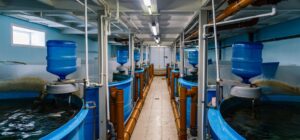
Fish farm tanks
Health check
We know that bristle worms can eat sludge, so the next question is whether they can be safely fed to farmed fish destined for human consumption. This is the focus of ongoing study at Norwegian research organisation SINTEF.
In an article last October (“Sludge from salmon hatcheries will become a sought-after resource”) for the financial daily Dagens Næringsliv, SINTEF’s Ida Grong Aursand, Andreas Hagemann and Stine Wiborg Dahle, explained: “At present, it is not permitted to commence the sludge-based rearing of bristle worms for use as salmon feed. This is because we are currently uncertain as to whether bristle worms can transfer unwanted components, such as microorganisms, from the sludge they eat into the food chain.
“To date, we have yet to identify a bristle worm containing either a bacterium or a virus after having eaten sludge to which such organisms have been added. If future research gives us the evidence we need to declare bristle worms as risk-free, these annelids may become Norway’s next mass-produced feed organism.”
The biological know-how and the technology needed to commence the sludge-based rearing of bristle worms are already in place. A cluster of Norwegian companies are now hoping to obtain public funding via the Research Council of Norway’s Green Platform initiative to construct a pilot facility at Tjeldbergodden.
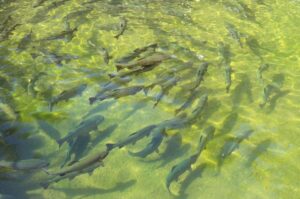
Trout in fish farm
SINTEF estimates that if the sludge from all existing Norwegian hatchery facilities was collected and used to rear bristle worms, it would generate an annual production of 1,400 and 540 tonnes of proteins and lipids respectively. While this is only a fraction of the aquaculture industry’s requirements, it would go some way towards reducing the pressure on wild-caught marine ingredients.
In the meantime, the SINTEF article stresses that it is already permitted to use nutrient salts from fish farm sludge to grow plants.
Specifically, microalgae represents a possible source of proteins and lipids.
As the old saying goes: “Where there’s muck there’s brass” or to put it another way, “Where there’s sludge, there’s value – if you know how to find it.”

